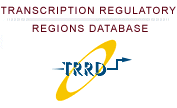|

|
List of the digital codes of experiments
- 1. Footprinting reactions:
- 1.1.DNAase I:
- 1.1.1. with crude nuclear extract
- 1.1.2. with mutated oligonucleotides
- 1.1.3. comparison between fragments of different genes
- 1.1.4. in the presence of increasing amounts of a competitor
oligonucleotide
- 1.1.5. in the presence of pure protein
- 1.1.6. in the presence of crude nuclear extract and
antibodies for transcription factor
- 1.2. methidiumpropyl-EDTA.Fe(II)
- 1.3. DNAse II footprint
- 1.4. hydroxyl radicals
- 1.5. footprinting in vivo
- 1.6. ortophenantroline cooper footprint (OPCU)
- 2. Exonuclease digests
- 2.1. exonuclease III
- 2.2. alpha exonuclease
- 3. Electrophoretic mobility shift assays (EMSA):
- 3.1. with crude nuclear extract
- 3.2. using oligonucleotides for comparison or competition
- 3.2.1. corresponding to the binding sites of the same type
from different genes
- 3.2.2. corresponding to binding sites of different types
- 3.2.3 corresponding
to binding sites and flanking sequences
- 3.3. with oligonucleotides carrying point mutations
- 3.4. cross-competition experiments
- 3.5. with purified or recombinant protein or with the
extracts from cells producing recombinant transcription factor
- 3.5.1. gel mobility shift assay with extracts enriched with
transcription factor
- 3.5.2. gel mobility shift assay with extracts deprived with
transcription factor
- 3.6. with crude nuclear extract and antibodies (supershift).
3.7. identification
of transcription factor from DNA-protein complex corresponding to
EMSA band
- 4. DNA modification reactions
- 4.1. methylation protection
- 4.2. methylation interference
- 4.3. ethylation protection
- 4.4. ethylation interference
- 4.5. demethylation
- 5. Primer extension assay
- 5.2 RACE ( rapid amplification cDNA 5'end)
- 5.5 RNase protection analysis
- 5.6 S1 nuclease protection
- 6. Transient expression analysis and experiments on
transgenic organisms or cells.
- 6.1. Analysis of deletions mutants:
- 6.1.1. deletion size is more than 30 b.p.
- 6.1.2. deletion size is up to 30 b.p.
- 6.1.3. an effect of insertions
- 6.2. An effect of point mutations on the expression
- 6.3. Conferring of sequence to a geterologous or homologous
promoters
- 6.3.1. Conferring of the regions more than 30 b.p.
- 6.3.2. Conferring of the separate site (up to 30 b.p.)
- 6.3.3 Conferring
of the region in direct and indirect orientations
- 6.4. Tandem repeats of the binding site.
- 6.5. Analysis of inducer (repressor) influence on the gene
expression
- 6.6. analysis of a reporter gene expression in the presence
of purified transcription factors or vectors expressing transcription factors of given
types.
- 6.6.1. influence of purified or recombinant transcription
factor on the reporter gene expression in vitro
- 6.6.1.1. wild type (intact) transcription factor
- 6.6.1.2. modified transcription factor (fusion proteins,
truncated proteins, with mutations, deletions, killer-factors etc.)
- 6.6.2. (in vivo) cotransfection assay
- 6.6.2.1. wild type (intact) transcription factor
- 6.6.2.2. modified transcription factor (fusion proteins,
truncated proteins, with mutations, deletions, killer-factors etc.)
- 6.6.3 analysis
of a reporter gene expression in vitro using extracts deprived
with transcription factor
- 6.6.3.2
analysis of a reporter gene expression in vivo using
cells without transcription factor
- 6.3.3.3
analysis of a reporter gene expression in vivo using cells
deprived with transcription factor (in the presence of
antibodies, oligonucleotides carrying binding site,
etc)
- 6.7. Transcription competition assay.
- 6.7.1. In the presence of oligonucleotides carrying intact
(wild type) binding site
- 6.7.2. In the presence of oligonucleotides carrying mutated
binding site.
- 6.8. expression of the reporter gene by plasmid
constructions containing regulatory region or unit being
investigated.
-
- 7. Homology of the binding site:
- 7.1. with consensus of fixed type
- 7.2. with the binding site from regulatory region of the
homologous gene
- 7.3. with the binding site of the same type from regulatory
region of dissimilar gene
- 8. ABCD-assay (avidin-biotin complex DNA-binding assay)
- 9. Filter binding assay
- 9.2. using for comparison oligonucleotides corresponding to
binding sites of different types
- 9.3. with oligonucleotides carrying point mutations
- 9.5. In
situ binding of cloned transcription factors to synthetic
oligonucleotides
- 10. DNA-cellulose competition binding assay
- 11.1 Protein- DNA immunoprecipitation assay (immunoselection)
- 11.2 Chromatin immunoprecipitation
revised October , 2003
|
